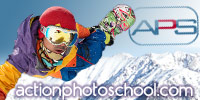As I always mention, the model/athletes are very important to capture a great shot. If you work WITH the athlete and have them give you suggestions, I can guarantee better shots. Sometimes what you think is possible is unrealistic for the athlete, and you can really annoy them by suggesting too many impossible ideas.

The setup for this image is actually fairly simple. I used my Nikon D300 with the 12-24mm lens set to 12mm at ISO 250, f/5.6, 1/10 shutter speed. I chose the slow shutter speed to make sure the lights in the tunnel showed up, and was crouching on the ground with the camera braced on my knee to make sure the tunnel was sharp with no camera shake.
I used 3 flashes to capture the image, all triggered with PocketWizards. One Alienbee B1600 at about 1/2 power to the right and behind the jump with a turqoise gel. Another B1600 camera left set just bright enough at about 1/4 power to add some light to the athlete with a high-output reflector. The third flash is zoomed to about 70 degrees and aimed at the athlete from far left, just barely out of frame to help ensure less shadows on the athlete.
The camera was tilted to the right to accentuate the texture and lines, and create a more dramatic look. When I'm shooting anything urban or man-made, I look for great textures and unique features, and work to incorporate them into the final image. Snow was thrown on the wall to help the athlete slide across it and make it to the slightly more piled snow landing just inside the tunnel. You'll notice that I work with a lot of colored gels, and this is because they help make my images different. Anything that will help set me aside more from other photographers I will always try to work with.
Before you take the picture, think about exactly where the athlete will be and scout every angle. Work with the natural features to create something truly unique, and don't crop in tight or the shot may not make sense. Once you have an angle, set up your flashes one at a time, and test them as you add more. This will allow you to see what each one is doing, and help you get it right when it's time to shoot. Once you've nailed the shot, and if your athletes want to continue working, shoot more angles! Maybe the first angle won't have been the best in the end.
That's the BUZZ for Today! Please check back soon for more.








0 comments:
Post a Comment